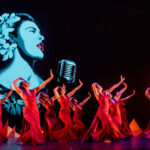Embarking on your journey to a dance career often involves auditions, and in today’s world, video auditions are a crucial component of this process. Whether you’re aiming for a Bachelor of Fine Arts (B.F.A.) or a Bachelor of Arts (B.A.) in Dance, understanding how to create a compelling dance audition video is essential. This guide will walk you through the key aspects of preparing and filming your dance audition, drawing insights from university audition guidelines to help you shine on screen.
Understanding Dance Auditions for B.F.A. and B.A. Programs
For many prestigious dance programs, like those at Point Park University, the audition is a critical step in the application process. Typically, applicants must first complete an academic application before scheduling their dance audition. Universities often utilize platforms like Accept’d for managing these applications, where you’ll create an account to upload your dance materials and register for an audition date, whether in-person or via video submission. It’s important to note that there is usually an artistic review fee associated with dance program applications, which is non-refundable.
In-Person Dance Auditions: A Brief Overview
While this guide focuses on video auditions, understanding the structure of in-person auditions can provide valuable context. On-campus audition days often involve a class setting where applicants demonstrate their abilities across various dance styles like ballet, hip hop, jazz, or modern. These sessions are designed to assess your skills in a live class environment, and solo variations are typically not part of the format. In-person audition days may also include campus tours and Q&A sessions with faculty, offering a comprehensive experience of the dance program.
For those attending in-person auditions, remember to bring essential materials such as a performance resume, a headshot, and potentially a full-body photograph depending on your chosen dance concentration. Specific photograph requirements exist, particularly for Ballet, Jazz, and Modern concentrations, often involving poses like first arabesque and specific attire such as leotards and tights for female-identifying candidates, and tights and fitted shirts for male-identifying candidates. Attire for the audition itself is also prescribed, varying by dance style, from classical ballet attire to more relaxed, form-fitted dancewear for hip hop.
Creating a Standout Dance Audition Video: Your Digital Stage
In situations where attending an in-person audition isn’t feasible, or as an increasingly common option offered by dance programs, the video audition becomes your primary stage. Creating a compelling dance audition video requires careful planning and execution. Here’s a detailed guide to ensure your video effectively showcases your talent:
Technical Aspects: Setting the Stage for Success
Filming Quality: Your video should be clear and well-lit. Use a stable camera or tripod to avoid shaky footage. Good lighting is crucial, ensuring you are clearly visible throughout your performance. Natural light or consistent indoor lighting works best.
Sound Quality: Ensure the music is clear and at an appropriate volume, balanced with the visibility of your movements. If music tracks are provided, use them as instructed.
Framing and Background: Frame your shot so your entire body is visible throughout the dance. Choose a clean, uncluttered background that doesn’t distract from your performance. A dance studio or a simple, neutral space is ideal.
Performance Aspects: Showcasing Your Artistry on Camera
Showcase Your Strengths: Select pieces that highlight your technical skills and artistic expression within the required styles. Energy and passion translate well on video, so perform with commitment and engagement.
Slate Information: Begin each section of your audition video with a slate. Clearly state your full name and the section you are about to perform (e.g., Ballet, Modern, Jazz, Hip Hop, Improvisation). This is crucial for identification and organization by the audition panel.
Music Selection: Adhere to any provided music resource lists. Using suggested music demonstrates your ability to follow instructions and perform to appropriate musicality. If you have choices, select music that enhances your performance and aligns with the style of dance.
Rehearsal and Practice: Practice extensively in the space where you will be filming. Get comfortable with the choreography and how it looks on camera. Do test recordings to check lighting, sound, and framing, and make adjustments as needed.
Editing (Keep it Minimal): While some minor editing for slate insertion and section breaks is expected, avoid excessive editing or special effects. The focus should be on your raw dance ability and performance quality. The authenticity of a single take performance often resonates more strongly.
Specific Video Requirements by Dance Style
For Ballet, Modern, and Jazz video auditions, you’ll typically film four separate pieces: Ballet, Modern, Jazz, and Improvisation. For Hip Hop, the format often includes three pieces: a Hip Hop combination, a street jazz combination, and Freestyle/Improvisation. Always refer to the specific guidelines of the program you are applying to for the most accurate requirements.
Music Resources for Your Dance Audition Video
Utilizing the suggested music resources is often a requirement for video auditions. Here are examples of music resources that might be provided, similar to those at Point Park University:
Ballet:
- Adagio: Adagio/Chopin Prelude in Db
- Pirouette: Center Tendu/Guantanamera
- Petit Allegro: Jeté/Drowsy Maggie
- Echappe: Beats or Frappe/Nazareth: Sarambeque
- Pirouette en pointe: Medium Tendu/De Falla: Danza de Gnomos
- Tour en l’air: Grand Battement/Tango in Bb minor
Jazz:
- Fly Around, Cirque du Soleil
Modern:
- Section A: Momofassa, Geoff Bennett
- Section B: Voodoo, Geoff Bennett
Hip Hop:
- (Refer to the specific audition guidelines for updated Hip Hop music resources)
Training and Preparation: Building Your Foundation
Regardless of whether you are auditioning in person or via video, solid dance training is paramount. Aim for at least 10 hours of weekly training for a minimum of three years, focusing on developing a strong understanding of key principles such as:
- Proper placement specific to your chosen genre.
- Coordination and balance.
- Epaulement (lines connecting upper and lower body).
- Weight shifting and control.
- Adaptability and versatility across styles.
- Musicality and rhythmic accuracy.
Proficiency in your chosen concentration and a working knowledge of other dance areas will make your audition, whether live or on video, significantly stronger.
Audition Decisions and Next Steps
Admittance to dance programs is based on a combination of academic qualifications and artistic talent, as demonstrated in your audition. Universities typically require both academic and artistic acceptance. You will usually receive your artistic decision after your academic application has been processed. Notifications regarding artistic admission and potential merit-based awards are generally sent via email and letter.
For any questions throughout your audition process, universities provide resources such as FAQs and contact information for their Conservatory or Dance departments.
Conclusion: Presenting Your Best Dance Self on Video
Creating a successful dance audition video is about more than just recording your performance. It’s about thoughtfully presenting your skills, artistry, and potential in a digital format. By paying attention to technical details, performance quality, and adhering to the specific requirements of each program, you can create a compelling video that effectively showcases your talent and passion for dance. Embrace the opportunity to use video to your advantage, and let your dance speak volumes on screen.


